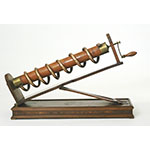Model of a water-lifting device called Archimedean screw or cochlea. The wooden base carries a hinged frame whose slope can be adjusted by resting it against one of the notches carved into the base. The frame carries a wooden cylinder fitted with a handle and a helical copper channel on the outside. Turning the handle raises a ball placed at the lower end of the channel. It is now believed that a similar contrivance, albeit with different construction features, was invented by Archimedes. The cochleas used in antiquity were effectively composed of a wooden tube containing a concentric axle. Between the axle and the tube, several partitions were attached in a helical, parallel sequence, resembling that of a helical staircase. Archimedean screws are still used today, particularly for raising liquids carrying suspended matter and debris. Resembles item inv. 999. Provenance: Lorraine collections.










